

Discovery boosts theory that life on Earth arose from RNA-DNA mix. Gene therapy injection in one eye surprises scientists by improving vision in both. In a landmark phase 3 clinical trial, the international team, coordinated by Dr Patrick Yu-Wai-Man from the University of Cambridge and Dr José-Alain Sahel from the University of Pittsburgh and Institut de la Vision, Paris, successfully treated 37 patients suffering from Leber hereditary optic neuropathy (LHON).
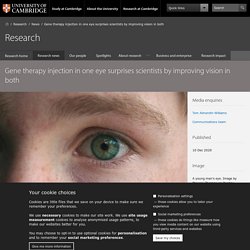
Subject to further trials, the treatment could help thousands of people across the world to regain and retain some of their sight. The study, published today in the journal Science Translational Medicine, indicates that 78% of treated patients experienced significant visual improvement in both eyes. It suggests that the improvement in vision in untreated eyes could be due to the transfer of viral vector DNA from the injected eye. LHON affects a specific type of retinal cells, known as retinal ganglion cells, causing optic nerve degeneration and rapidly worsening vision in both eyes. CRISPR Scientists Hack Patient’s Genes in Bid to Cure Blindness. For the first time, doctors have attempted to cure blindness by gene-hacking a patient with CRISPR technology.

A team from Oregon Health & Science Institute injected three droplets of fluid that delivered the CRISPR DNA fragments directly into a patient’s eyeball, The Associated Press reports, in hopes that it will reverse a rare genetic condition called Leber congenital amaurosis, which causes blindness early in childhood. “We literally have the potential to take people who are essentially blind and make them see,” Charles Albright, chief scientific officer of Editas Medicine, told the AP. Editas is one of the biotech companies that actually developed the treatment.
“We think it could open up a whole new set of medicines to go in and change your DNA.” While some genetic conditions can be treated with conventional gene therapy, which would replace the entire mutated gene rather than editing it, patients with Leber congenital amaurosis were out of luck. The Teeth of Early Neanderthals May Indicate the Species' Lineage Is Older Than Thought.
In a cave called the ‘pit of bones,’ up in the Atapuerca Mountains of Spain, a collection of 430,000-year-old teeth are curiously smaller than might be expected for the skulls they were found with.
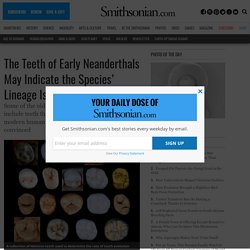
The anomaly has one scientist suggesting that the lineages of modern humans and Neanderthals split some 800,000 years ago, tens of thousands of years earlier than genetic studies have estimated. Aida Gómez-Robles, an anthropologist at University College London, studies how ancient hominin species’ teeth evolved over the ages. She believes that because the ancient teeth look too modern for their era, they must have evolved unusually quickly or, as she finds more likely, had more time to evolve than has been generally believed. The new research was published today in Science Advances. As various hominin species evolved, their teeth changed in notable ways, generally becoming smaller over time. Engineers create ‘lifelike’ material with artificial metabolism. As a genetic material, DNA is responsible for all known life.
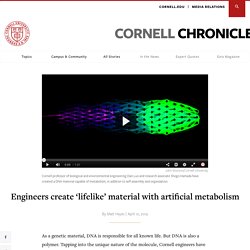
But DNA is also a polymer. Tapping into the unique nature of the molecule, Cornell engineers have created simple machines constructed of biomaterials with properties of living things. Using what they call DASH (DNA-based Assembly and Synthesis of Hierarchical) materials, Cornell engineers constructed a DNA material with capabilities of metabolism, in addition to self-assembly and organization – three key traits of life. “We are introducing a brand-new, lifelike material concept powered by its very own artificial metabolism. We are not making something that’s alive, but we are creating materials that are much more lifelike than have ever been seen before,” said Dan Luo, professor of biological and environmental engineering in the College of Agriculture and Life Sciences. The paper, “Dynamic DNA Material With Emergent Locomotion Behavior Powered by Artificial Metabolism,” published April 10 in Science Robotics.
5 Brits Take A DNA Test. More than 26 million people have taken an at-home ancestry test. As many people purchased consumer DNA tests in 2018 as in all previous years combined, MIT Technology Review has found.
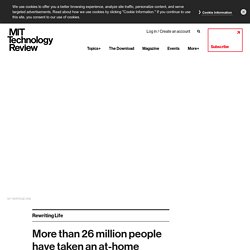
Surging public interest in ancestry and health—propelled by heavy TV and online marketing—was behind a record year for sales of the tests, which entice consumers to spit in a tube or swab their cheeks and ship the sample back to have their genomes analyzed. By the start of 2019, more than 26 million consumers had added their DNA to four leading commercial ancestry and health databases, according to our estimates. If the pace continues, the gene troves could hold data on the genetic makeup of more than 100 million people within 24 months. The testing frenzy is creating two superpowers—Ancestry of Lehi, Utah, and 23andMe of Mountain View, California. The crazy business of DNA - clareluxor - Gmail. Scott Kelly's Year in Space Changed His Gene Expression. (Editor's Note: This story was updated on March 15 at 1:15 pm E.T.
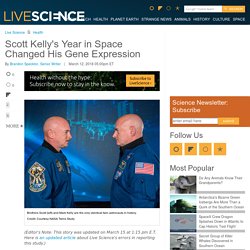
Here is an updated article about Live Science's errors in reporting this study.) Scott and Mark Kelly are identical twin brothers — at least, they were until Scott spent a year living in space. When Scott Kelly returned to Earth after a 340-day voyage aboard the International Space Station (ISS) two years ago, he was 2 inches taller than he'd been when he left. His body mass had decreased, his gut bacteria were completely different, and — according to preliminary findings from NASA researchers — his gene expression had changed significantly.
Octopus And Squid Evolution Is Officially Weirder Than We Could Have Ever Imagined. Climate change will affect how many boys are born worldwide, scientists say. Specifically, climate change could alter the proportion of male and female newborns, with more boys born in places where temperatures rise and fewer boys born in places with other environmental changes, such as drought or wildfire caused by global warming.
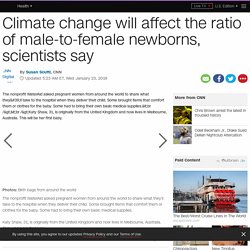
Last summer, Fukuda and his colleagues published a separate study looking at births in areas hit by environmental events that caused extreme stress. They included Hyogo Prefecture after the Kobe earthquake of 1995; Tohoku after the Great East Japan Earthquake of 2011 (and subsequent nuclear disaster at the Fukushima Daichii power plant); and Kumamoto Prefecture after the 2016 earthquakes. Nine months after these disasters, the proportion of male babies born in these prefectures declined by between 6% and 14% from the previous year. This data supports the idea that major stress affects gestation, which in turn alters the newborn sex ratio, Fukuda and his co-authors wrote. The newborn sex ratio. Scientists reveal 10,000-year-old mummy is Native American ancestor. Scientists attempting to map out the historical migrations of North and South America by analysing ancient bones have revealed that a 10,000-year-old skeleton unearthed in a cave in Nevada is the ancestor of a Native American tribe.

The iconic skeleton, known as the “Spirit Cave mummy”, was reburied this summer by the Fallon Paiute-Shoshone people in Nevada, bringing closure to a decades-long legal dispute with anthropologists who fought for it to remain on display in a museum. DNA painstakingly extracted from the ancient skull proved the skeleton was an ancestor of the tribe and discredited a longstanding theory that the individual was from a group of “Paleoamericans” that existed in North America before Native Americans. The full genetic details of the skeleton, which is the world’s oldest natural mummy, are published as part of a wide-ranging international study of the ancestry of North and South America. Investigators searched a million people’s DNA to find Golden State serial killer.
Investigators may have compared a serial killer's DNA with that of one million unwitting genealogy enthusiasts as part of an investigation that led to the arrest earlier this week of a man accused of being California’s elusive “Golden State Killer.”

“I had no knowledge this was happening,” says Curtis Rogers, co-creator of GEDMatch, an ancestry site that a police source yesterday identified as one of those employed by investigators. Officials in California said they had found and arrested Joseph James DeAngelo, 72, for a fearsome series of murders and rapes between 1974 and 1986 after using commercial genealogy websites, including GEDMatch, to locate one of his relatives. GEDMatch, a no-frills website that has never advertised, is used by amateur and professional genealogists to upload and compare DNA tests, effectively crowdsourcing vast family trees. It has been growing quickly and is now approaching one million users, says Rogers. Catching a killer. There's No Scientific Basis for Race—It's a Made-Up Label.
This story is part of The Race Issue, a special issue of National Geographic that explores how race defines, separates, and unites us.
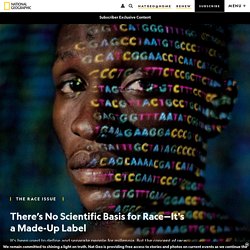
In the first half of the 19th century, one of America’s most prominent scientists was a doctor named Samuel Morton. Morton lived in Philadelphia, and he collected skulls. Why Siblings Can Get Different Results From DNA Ancestry Tests. Learn how your family ancestry is connected to the human origin journey with National Geographic’s Geno DNA Ancestry Test. Last fall, siblings Kat and Eddy Abraham decided the best birthday gift for their dad involved a couple vials of spit. “He’s the historian of the family,” Kat says, so the brother and sister duo thought he’d enjoy seeing the results from a genetic ancestry test.
Knowing that their father’s side of the family is Lebanese and their mom’s family is, as Kat describes her, “some variety of white Canadian,” they expected the results would show that they are both half Middle Eastern and half European. For the most part, that’s what they found. But the siblings were at first surprised to see that their results were not entirely the same. Mitochondria mutations mystery click 2x. You probably know about the 23 pairs of chromosomes safely stowed in your cells’ nuclei. That’s where the vast majority of your genes can be found. But there are 37 special genes — a very tiny fraction of the human genome — located in mitochondria, the structures inside your cells that breathe and produce energy.
Repeated copying of mitochondrial DNA introduces errors; if not kept in check, these mutations can give rise to incurable diseases like Leigh syndrome and Leber’s optic neuropathy. Worldwide, more than 1 in 10,000 people are affected by disorders resulting from mitochondrial genome defects. Ancient humans and Denisovans mated click 2x. Study finds that genes play a role in empathy. A new study published today suggests that how empathic we are is not just a result of our upbringing and experience but also partly a result of our genes. Empathy has two parts: the ability to recognize another person's thoughts and feelings, and the ability to respond with an appropriate emotion to someone else's thoughts and feelings. The first part is called 'cognitive empathy' and the second part 'affective empathy'. Fifteen years ago, a team of scientists at the University of Cambridge developed the Empathy Quotient (EQ), a brief self-report measure of empathy.
Fathers pass on four times as many new genetic mutations as mothers – study. Children inherit four times as many new mutations from their fathers than their mothers, according to research that suggests faults in the men’s DNA are a driver for rare childhood diseases. Researchers studied 14,000 Icelanders and found that men passed on one new mutation for every eight months of age, compared with women who passed on a new mutation for every three years of age. The figures mean that a child born to 30-year-old parents would, on average, inherit 11 new mutations from the mother, but 45 from the father. Kari Stefansson, a researcher at the Icelandic genetics company, deCODE, which led the study, said that while new mutations led to variation in the human genome, which is necessary for evolution to happen, “they are also believed to be responsible for the majority of cases of rare diseases in childhood.”
Google Has Released an AI Tool That Makes Sense of Your Genome. We Can Observe Memories Being Passed Down Through Generations. Genetic Hand-Me-Downs. Genetics. Tracing Ancestry, Researchers Produce a Genetic Atlas of Human Mixing Events - The New York Times. Genes for Skin Color Rebut Dated Notions of Race, Researchers Say - The New York Times.
Gene-Edited Skin Could Be Its Own Blood-Sugar Sensor - MIT Technology Review. For diabetics, the constant finger pricks to obtain a blood drop and measure its glucose level is an annoyance. Epigenetics / 4DN. Your Childhood Experiences Can Permanently Change Your DNA. A version of this article was originally published on Univision. Read the original in Spanish here. DNA is the genetic material that makes us who we are, determining our physical characteristics and even helping to shape our personality.
Human ancestry correlates with language and reveals that race is not an objective genomic classifier. The uncertain future of genetic testing. The Plot Thickens in the Gnarly Story of IQ and Genetics. Not everyone thinks the future will look so different, though. Transgender People and “Biological Sex” Myths – Julia Serano – Medium. Note: The day this was published, H.R. 2796 — a U.S. congressional bill that would legally re-define “man” and “woman” based on an individual’s “genetic sex,” as a means to rollback transgender rights — started to garner news & media attention.
While this essay was not intended to address that bill specifically, it thoroughly undermines its logical, legal, and scientific standing. A New DNA Sequencing Startup Wants to Pay You For Your Genetic Data. Scientists Are Inching Closer to Bringing Synthetic Human DNA to Life. Ancient Microbes Found in Neanderthal Plaque DNA. Autism Researchers Discover Genetic ‘Rosetta Stone’ Distinct sets of genetic defects in a single neuronal protein can lead either to infantile epilepsy or to autism spectrum disorders (ASDs), depending on whether the respective mutations boost the protein’s function or sabotage it, according to a new study by UC San Francisco researchers.
Tracing how these particular genetic defects lead to more general changes in brain function could unlock fundamental mysteries about how events early in brain development lead to autism, the authors say. 4 Beneficial Evolutionary Mutations That Humans Are Undergoing Right Now. Most random genetic changes caused by evolution are neutral, and some are harmful, but a few turn out to be positive improvements. These beneficial mutations are the raw material that may, in time, be taken up by natural selection and spread through the population. Multiplexing Genetic and Nucleosome Positioning Codes: A Computational Approach. Physicists Find More Evidence That DNA’s Hidden Layer is Real. Craig Venter: Watch me unveil "synthetic life" Riccardo Sabatini: How to read the genome and build a human being. Scientists Identify Gene Behind Evolution in Action in Darwin's Finches. Researchers Observe Grafted Plants Sharing Genomic Information. 23andMe Rides Again: FDA Clears Genetic Tests To Predict Disease Risk.
Gene drives spread their wings. Making of Europe unlocked by DNA. DNA/genetics. DNA. Genetics. DNA from the Beginning -animated experiments. Might Alien Life Evolve Like the Incredible Octopus? Did natural selection make the Dutch the tallest people on the planet? I am # 234,335 of first million genomes at 23 & me. Learn Genetics. DNA and Genetics Interactive.
Human Genetics Highlights. DNA study shows Celts are not a unique genetic group.